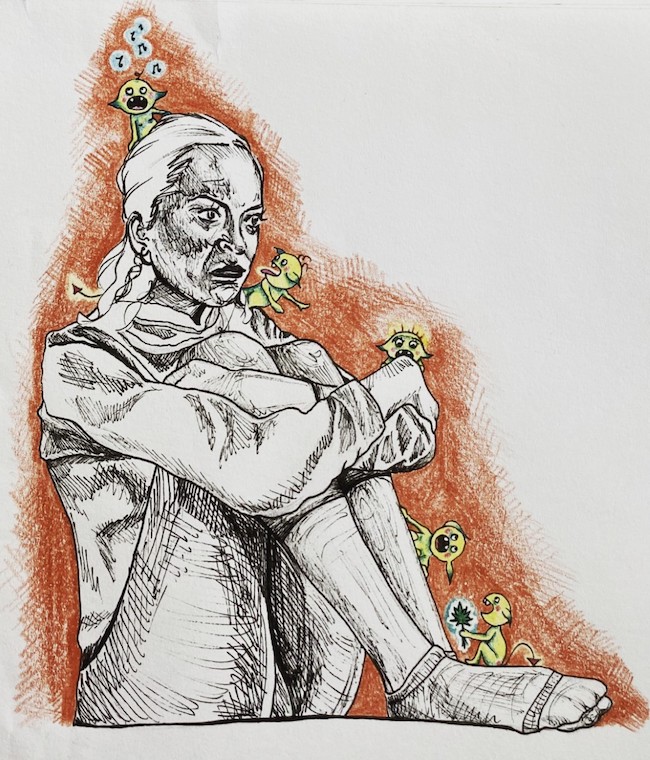Yesterday, I physically interacted with a record number of four people – from a CDC-certified distance, of course — and two dogs.
For those of us sheltering in houses with close friends and/or family members, this might seem like an abysmal amount of social interaction. While I currently live alone and am slowly adapting to the long stretch of solitude ahead of me, I know others are going borderline-crazy in too-small spaces with well-meaning but, perhaps, a few too many people.
Quite honestly, I’m not sure which is better: to live alone in an absolutely bizarre, scary time, or to live in solidarity with other stressed-out, pent-up people. Sure, they may exacerbate your stress, but they’re almost always available for a prolonged vent session or just-one-more-episode of “Tiger King.”

This unanticipated season of life has pushed me to consider the meaning and value of solitude, a practice that is revered across numerous belief systems. Solitude is often viewed as a way to become closer to God, demanding silence and attunement to our craziest, scariest thoughts – what I imagine as our mental gremlins. It invokes contemplation, of both ourselves and our surroundings, as well as a sense of mystery: who do we become, and what do we create, when we are alone?
Those who choose to be alone are not only dubbed mysterious, but have also been associated with mysticism, witchcraft, and asceticism. The so-called “lone wolf” leans away from us and toward the other: the nocturnal, the subterranean, the dark, the morbid. While lone wolves tend to diverge from cultural expectations, their pursuit of solitude often brings about both personal and cultural change. I think of our cultural fascination with famed, often nocturnal artists who create in solitude, driven by a propitious mixture of drugs, black cats, and moonlight. “Without some degree of solitude,” Sangharakshita, a Buddhist teacher, writes in ‘Reflections on Solitude,‘ “reflection is impossible, and without prolonged reflection no great work of art was ever brought forth.”
Of course, there are plenty of artists who reflect and create, in solitude, during the daytime. Wolfgang Laib, a German artist, comes to mind: since the 1990s, he has hand-picked pollen – alone – within his village, then arranged the pollen in various geometric arrangements for public viewing in major art museums. Laib’s meticulous, humble, and mostly silent practice is a solo yet highly connective activity, one that returns him to himself, to his physical environment, and to those who view his work.
Laib’s work reminds us that solitude is not necessarily dark, depressing, lonely, or senseless. Nor is it a static state of being; the solitude that I know (or, at least, that I’ve been learning to know) is an intimate process, a form of emotional labor that can yield beautiful colors: pure, bright, almost offensively cheery yellows, like those seen in Laib’s work. To me, and presumably many others, solitude is also distinct from loneliness. As articulated by author Parker Palmer, solitude “is not about the absence of other people, it is about being fully present to ourselves, whether or not we are with others.”
All of this is not to say that I am in full support of becoming a 24/7 soloist. Choosing to occupy these bubbles of doubt, fear, anxiety, and uncertainty is challenging, and not always healthy. It’s certainly easier to choose schoolwork — my faithful distractor — over reading the news or performing a self-evaluation, microwaving over mindful cooking, and “Tiger King” over meditation. Yet when I’ve selected the “harder” route — the road less traveled by my busy brain – I’ve often emerged with a more intimate understanding of my thoughts, or the needs of our local community, or just the simple pleasure of a homemade meal over a freezer-burned enchilada.
Over these next few weeks, I invite myself — and others — to lean into moments of solitude, uninterrupted by negative chatter or loud music or self-imposed obligations. Read, write, draw, dance, pick pollen, or simply sit on the edge of your bed and stare at the dresser. Mental gremlins, when acknowledged and even nurtured, might give rise to the wild idea or long-forgotten story that must be shared, jettisoning us from a moment of solitude to connect with another person.






